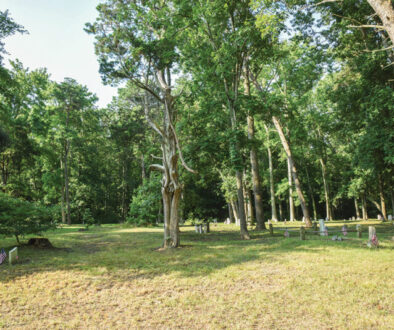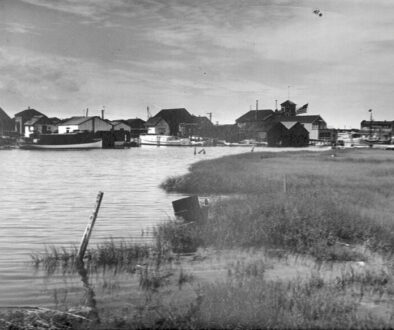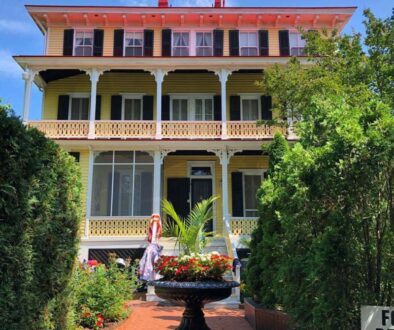Passion and Purpose
A profile of naturalists Pat and Clay Sutton
Pat and Clay Sutton are well traveled and internationally known for their research, teaching and books on birds, butterflies and native plants. They are happiest, though, at home in a humble farmhouse, partially surrounded by the 11,500-acre Cape May National Wildlife Refuge, an area they helped create and conserve.
Their property is about 15 miles north of Cape May off Route 47 as the highway crosses Bidwell’s Creek, which flows into Delaware Bay. Their 1845 Thomas Peterson House is in a clearing just beyond dense wetland woods. The sign out front at the arbor reads: “Do not spray. Pollinator Garden”


Pat Sutton is not bashful about the reasons for the sign. “We have it out because people regularly call and ask for mosquitoes to be sprayed. We do not want our property sprayed with poisons and have called the Cape May County Department of Mosquito Control to be on the NO SPRAY list. They avoid our house, turn the sprayer off, but we’re hoping people begin to make the connection—that spraying is hazardous to honey bees, native butterflies and bees, and undoubtedly us. With so much salt marsh and wet woods around us, mosquitoes are part of the landscape. That’s why we have a screened-in porch.”
Pat is a natural teacher about all things natural. The Suttons’ wildlife garden wraps around their home. It has been a work in progress since 1977, when they purchased the half-acre property. “We had rented a house on several hundred acres at Tick Neck on Bidwell’s Creek,” Clay says. “Obviously well-named because it was, indeed, very ticky. After two years the owner raised the rent. It was time to find a place of our own. We drove out the two-mile lane, turned onto Bucks Avenue, saw a For Sale sign, stopped, and bought this house. Ironically, later we learned this property, where this house sits, was once my great-grandfather’s farm, owned by Crawford Buck, for whom this avenue is named.”
As the Suttons’ wildlife garden developed and grew, in the variety of plants and the wildlife it attracted, Pat’s schedule of workshops and garden tours, local and national, expanded to include: Creating a Pollinator Garden for Butterflies, Hummingbirds and Bees; Milkweeds for Monarchs; Seashore Gardening with Native Plants; Weeds for Wildlife; Shade Gardening with Natives; Make Messy Look Good; Create a Wildlife Meadow; Create a Wildlife Pond; A Dragonfly Primer; Landscape Design with Wildlife in Mind.
The trial and error laboratory for her study and teaching is at the rear of their house.
The garden is visible through all the seasons from their screened porch and dining table. “Our little one-half acre has attracted 75 different butterflies and 212 different birds since 1977,” says Pat. “I think that is pretty remarkable.”
On a sunny afternoon this June, the garden was alive with wildlife action. Bright red Bee Balm and Purple Coneflowers nodded in a light breeze. Bees buzzed the honeysuckle, Black Swallowtail butterflies fluttered about the sunflowers. Grasshoppers jumped on the budding Joe-Pye Weed. Water Lilies lazed in the ponds as frogs croaked and leaped the lily pads. Dragonflies dive bombed the water. Wild Columbine danced in the breeze with Jacob’s Ladder. Goldfinches nipped at seed heads. Songbirds chirped a chorus from trees on the perimeter. Pat explained birds dropped the seeds for many of the trees: the Hackberries, Red Maples, Red Cedars and American Hollies. “Clay pays attention to protect the little seedlings—nurtures them rather than cutting them off,” Pat says.
Though Pat and Clay Sutton have authored six books and have taught and consulted for more than 40 years, they get excited about the simplest of natural experiences.
“Oh, look Clay,” says Pat, picking up binoculars, “a Ruby-Throated Hummingbird.” Clay reached for his binoculars and focused on the hummingbird taking a sip from the garden feeder. It is the Suttons’ attention to the details of every bird, butterfly and bee they observe that makes their joie de vivre so contagious in their speaking and writing.
Pat says it was in 1975 that Clay first put binoculars in her hands and showed her how to use them. It was in Florida where they took a camping trip soon after they met and were traveling in the Everglades when Pat spotted a big white bird, a Great Egret. “Clay stopped so I could get a good look,” says Pat. “Traveling a bit further, I saw another big white bird, and Clay stops again. Five or six times, I spot a big white bird, and Clay stops. He was patient, he didn’t burst my bubble. I was rediscovering the same Great Egret! But I got hooked. I fell in love with that bird, with bird watching—and Clay.”
Clay Sutton has been studying birds and the natural environment since he was a boy. He grew up in Stone Harbor when it was a small seaside town of little cottages. “There were 12 students in my elementary school class of 1963,” he recalls. “There was nothing but dunes and dune forest for the 30 blocks from Avalon to Stone Harbor, and there remained a dense wild forest at Wildwood.”


In describing his deep local roots, Clay explained in one of his books that on his father’s side, “We have always been birders of sort—not the binoculars—or, at the time, spyglass-carrying type, but baymen, hunters and fishermen. My great-great grandfather captained a coastal schooner, and my great-grandfather, Captain William Sutton (1838–1910) was one of the first non-Native American people to live on the island that is now Sea Isle City. He went out to sea at eight years old as a cabin boy, and by twenty-one, he was master of his own vessel, sailing mainly to southern ports. In later years he was a hunting guide, taking parties out for $2.50 a day. He guided birding parties too, including ornithologist Witmer Stone.”
Clay says he first learned of Witmer Stone when he bicycled to lectures given by the local nature study club on Seven Mile Beach. He says veteran bird watchers welcomed him though he was the only youngster attending. Witmer Stone [1866–1939] was a preeminent ornithologist of his time and the first to put Cape May on the map as a bird watching mecca in his 1937 two-volume Bird Studies at Old Cape May. Only 1,400 of the numbered volumes were published by the Delaware Valley Ornithological Club, which Stone co-founded. Stone’s books are collector items, hard-bound, beautifully written and illustrated, describing 350 birds catalogued along the New Jersey coast—their physical appearance, habits, and migration. Stone wrote in vivid descriptive prose about the distinctive Cape May environment that supports the miracle of migration every season.
“We delight in the heavily shaded streets of town and in the farms and woodlands stretching down to the salt water—the linking as it were of upland and sea. The old fashioned weather boarded houses, windswept and bleached, with their steep gables and dormer windows, and their colonial doorways …….Towering above nearly every old house, be it in town or country, is a silver poplar, its smooth gray branches stretching up like the arms of some great supplicant giant……There are hedge pear trees, too, about the old houses, loaded with fruit until the branches break…and pink and white althea bushes with red tiger lilies and blue larkspurs in the gardens, the flower beds and paths all bordered with rows of conch shells.”
Stone was a frequent visitor to Cape May in all seasons beginning in 1890, and a summer resident for more than 20 years, into the 1930s. He worked at the Academy of Natural Sciences in Philadelphia for 51 years as mammalogist, botanist and ornithologist. He is remembered as “the last great naturalist,” especially for his field studies of shore birds and the plant life of the New Jersey Pinelands.
The 30-acre Stone Harbor Bird Sanctuary where Clay Sutton watched birds as a youngster was established in 1947 by members of the local bird club who named it after Witmer Stone. Some of old timers had accompanied Stone as he was among the first to document the herons, egrets and song birds populating the wind-swept dune forest.
On Clay’s 13th birthday his grandmother Laura Buck Sutton gave him Roger Tory Peterson’s Field Guide to Birds. He says with book in hand, he began to identify birds while exploring vast stretches of wetlands, still to be dredged and filled for development. He could not imagine then that some 45 years later, he and his wife would publish what has been described as a contemporary sequel to Witmer Stone’s books.
The Suttons’ Birds and Birding at Cape May – What to See—When and Where to Go, was published in 2006. Paul Kerlinger, Cape May author and bird migration expert, said at the time: “Not since Bird Studies at Old Cape May by Witmer Stone has there been such a complete guide to seeing birds in this area. Clay and Pat collectively have nearly 70 years of birding, teaching, photographing, watching butterflies, and studying birds in Cape May.”
The book includes maps and site descriptions (including precise directions to finding sites), a seasonal checklist of Cape May birds, summaries of hawk and seabird counts, a butterfly list of Cape May, weather information, photographs and histories of farms, woods and beaches that have become familiar names in international birding, among them: Higbee Beach, Rea’s Farm, Hidden Valley, South Meadows, Two Mile Beach, Nummy’s Island, Cooks Beach, Reeds Beach, and Kimble Beach.
Pat and Clay Sutton have written other books as well. They co-authored How to Spot Butterflies; How to Spot Hawks and Eagles; and How to Spot an Owl. Clay co-authored with Pete Dunne and David Sibley the classic Hawks in Flight.
Pat Sutton says it’s remarkable that she and Clay have worked so closely for so many years as a team with singular passion and purpose. They first met at a New Year’s Eve party in Pat’s native suburban Philadelphia. The party was a last minute decision for Pat, and she didn’t have a proper winter coat. Either she was to wear her beat-up yellow slicker, or her grandmother’s fur. She chose the fur. “Clay came onto me right away,” she says. “Not that I sparked him—it was the coat. ‘How could you?’ he asked. It was not only a rare leopard skin, but a baby leopard’s.” Pat explained it wasn’t her coat, it was her grandmother’s and she had no other warm coat to wear to the party. Clay continued to shame her, but one thing about nature led to another, and by the end of the evening, they were talking about birds.
Pat says she became a “born again birder” after that first trip to Florida with Clay, and decided to move to Cape May later that year to transition into the life of a naturalist. She says she found Cape May and environs were also in transition. The city’s nationally significant collection of historic architecture had been deteriorating for years, but was being rediscovered by preservationists to be designated a National Historic Landmark in 1976. When exploring along Delaware Bay at Higbee Beach to bird watch and pick beach plums, Pat found, “Four-wheelers and dune buggies from all over the state descending on the beach and enjoying a free-for-all in the ancient dune system. The roots of ancient trees, some 100 years old, were undermined by constant traffic on wide avenues cut through the dunes.” In 1978 that changed when the State of New Jersey took ownership of the area and began limiting access in order to curb vandalism.
Clay Sutton says when he returned home after graduate school in the mid-70s, he was “astounded to learn I lived, in essence, at the center of the birding universe.” He also was astounded at the reckless rate bulldozers were destroying dune forests, and infilling wetlands to make room for vast stretches of housing along the ocean and the bay. It was then, he says, he committed to “trying to document what was being lost and to save some of what was left.” He had a vision and a sense of urgency that bird studies of the New Jersey Cape needed to be updated; their natural habitats saved and expanded to protect the existence of millions of birds that depend on this area as a migratory pathway to seasonal homes in the north and south.


Clay worked toward his goals as a naturalist, field biologist, field guide and environmental planner and consultant. Pat became the Interpretive Naturalist at Cape May Point State Park for several years and for 21 years, the Naturalist and Program Director at the New Jersey Audubon Society’s Cape May Bird Observatory. The two worked together consistently to save existing migratory habitats and create new ones.
It took 30 years of their combined experiences and four years of focused writing to produce their book Birds and Birding at Cape May. During that time the wave of randomly destroying natural habitats took a positive turn away. “Gains were being made in land protection,” Pat observed. “There was a deep sense of hope when certain key Cape May tracts were preserved such as the South Cape May Meadows and Hidden Valley Ranch [an extension of the state Higbee Beach Wildlife Management Area]. On field trips I am always quick to point out how close we came to losing so much of this priceless heritage.”
The Suttons were involved in creating the Cape May National Wildlife Refuge, a U.S. Fish and Wildlife Service effort, started in the 1970s. Much of the refuge’s natural tracts of wet and dry forests, swamps, bogs and grasslands lie on the bayside along Route 47, north, from Rio Grande to Dennisville, and along Routes 610 and 550 from Dennisville, north, to Petersburg and connect to the Pineland National Preserve. Ultimately the refuge is to protect more than 21,000 acres of wildlife habitat on the Cape May peninsula.
Since the Suttons began their journey as naturalists, Cape May has grown exponentially in popularity as one of the best birding locations in the world. Nature’s enchantment that brought Pat and Clay together is likewise magic for millions of bird watchers, both experienced and novice. They come by the thousands to visit this special place on earth where the winds and geography create a migratory highway that directs millions of birds and butterflies to risk their seasonal journeys, stopping over briefly, for all of us to watch and be awestruck.

Bird studies at Old Cape May Book Club
Witmer Stone’s 1937 Bird Studies at Old Cape May has a book club of its own. Only 1,400 sets of books were printed and each is numbered. The late Sandra Sherman of the Delaware Valley Ornithological Club attempted to locate each and every one of the two-volume sets, the current owners, and stories of how the books were acquired.
I happen to be one of those lucky 1,400. The books are among my most precious possessions. I have set number 309. They were a gift—a peace offering of sorts—from a cousin-in-law from an Old South family in New Orleans whose claim to fame was that they manufactured boats for the Confederacy. My cousin-in-law was a writer and a man who loved his bourbon. He drank a lot of it for many years.
He hop-scotched through the Social Register, finding friends at fine seashore watering holes up and down the East Coast. He sometimes landed at my door with his guests. The most memorable was a 3am visit, accompanied by a guy with two canoes roped to the top of his SUV and a woman with two Russian wolfhounds—big as small ponies. They raided the refrigerator and found rooms on the third floor for themselves and the dogs. The next morning the shower overflowed with water and seeped through the second floor ceiling. Guest privileges were abolished henceforth.
A few years later, I received in the mail a set of Witmer Stone’s Bird Studies at Old Cape May which my cousin-in-law had purchased at a book sale in Aiken, South Carolina. He had found the perfect peace gift. I cherish the books. About the same time he gave up bourbon and other spirits, and visits every now and then with good manners and minus an entourage.
The list of owners of the Bird Studies at Old Cape May is updated on the Ornithological Society’s website by members who continue the project since Sandra Sherman’s passing. A majority of the books have been located, and their stories of discovery and inheritance are fascinating. I was referred to the project by local naturalist Keith Seager when I was interviewing him for a story about Higbee Beach for Cape May Magazine several years ago. He and several other Cape May area residents are proud owners of the books. – KF



